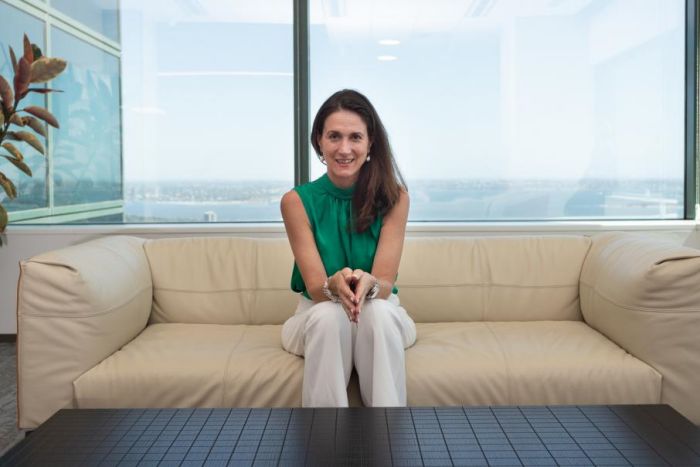An Interview With Tania Cecconi From CEOs For Gender Equity
Tania Cecconi is the Chief Executive Officer of CEOs for Gender Equity. The Western Australian organisation was convened in 2012 by the then Commissioner for Equal Opportunity. Tania joined in 2016 as the first paid executive officer. Whilst a lot of work was being done to improve gender equity at a boardroom level, there wasn’t anyone working with CEOs in Western Australia, and this has been the focus for the organisation.
Blooming Minds Director Tasha Broomhall recently chatted with Tania to learn more.
TB: Can you tell us a little bit more about CEO’s for Gender Equity?
TANIA CECCONI: I head up over 50 CEOs for gender equity in WA… We’ve got the highest gender pay gap in Australia and the most amount of men in senior roles. We work with CEOs to reframe gender equity as a business opportunity, as well as the talent opportunity.
TB: What has been achieved since convening in 2012?
TANIA CECCONI: Working in gender equity is such a long, long game. We’re dealing with entrenched biases. We’re dealing with the top end of town and we’re dealing with workplaces that have yet to catch up with the seismic shifts we’ve seen even over the last 30 years.
When I talk about these seismic shifts, we’ve seen a huge number of women enter the workforce. We’ve seen huge numbers of women graduate in higher numbers than men. We are now seeing women wield significant amounts of influence via spending power. Women influence 75 to 80 cents in every dollar and that’s not just on handbags and shoes. So quite often people will say, “Oh, you know, society needs to change”. Well, society has changed enormously, absolutely enormously, just over those last 30 years. We need workplaces to start catching up.
What I have seen change is when I first started, the conversation around gender equity was all about fixing women. Women could not be seen at the top because women couldn’t access senior roles because they didn’t have the same amount of education as men did. They hadn’t enjoyed unbroken trajectories to the top the same way that men had. It was often cited that women couldn’t juggle family and work as if they were mutually exclusive options. So I think we’ve seen the conversation shift enormously. No one in my group is talking about fixing women right now.
TB: That’s really fascinating to think about that shift in the conversation… Why is there still a difference in the boardroom, then? Why is the workplace not keeping up with the societal changes?
TANIA CECCONI: Well, it’s tricky, isn’t it? Because, like I said, it’s those shifts that we’ve seen that have yet to translate into the workplace. And many of these organisations were established by men for men, which means decisions and the processes and the systems that support those decisions around recruitment. How we promote talent, how we retain talent, are inherently biased. There are systemic barriers, if you like, I don’t believe there’s overt discrimination in the workplace. It’s very systemic. It’s organisational and you just have to look at the numbers to see that it doesn’t explain away why it’s still happening. But many of our CEOs do reflect on what they can do better and it’s quite confronting for them, personally.
TB: What are some of the things that they can do better at that CEO and senior leader level?
TANIA CECCONI: Number one, with any transformation in the workplace, we see that CEOs need to be really clear about a compelling reason to bring along their people. We see striving for gender equity and better gender balance at all levels within the business requires a really strong, articulated, compelling case… So that starts with a “why?” It starts with their personal why. Why it’s important to them, but also professionally,… why it’s important to their business,… to their stakeholders, why it’s important to their customers, why it’s important to their people.
They need to clearly be able to articulate across all of those dimensions. So that takes a bit of time. Quite often, CEOs will cite having daughters as a real driver for them. And it’s a real driver because it’s not until their daughters hit high school or university that they begin to hear about some of the challenges that they, their girls, may face.
TB: Interesting the different perspective that might give them. What are the implications for our society if we don’t actually get gender equity?
TANIA CECCONI: Well, I focus on the workplace perspective, which does have a knock-on effect on society. I think we’re seeing more and more leaders articulate and take a stand on issues that matter whether it’s Alan Joyce, head of QANTAS, talking about his commitment to LGBTQI, we’re seeing a lot more CEOs take a stand on their commitment to mental health and the campaigns that we see supporting mental health awareness.
I think what we’re seeing is that we’ve more CEOs articulating their commitment to a better balance in the workplace, more equity, more fairness. Number one they enhance their reputation, but they become more of a magnet to attract female talent. So it’s basically selling to society more broadly and to women and to men that women are welcome. They represent 50.4% of the population, it doesn’t make sense to exclude them. So, I think that’s one of the critical messages that CEOs have in terms of their impact on society.
It’s to say that we are part of the ‘rah-rah’ movement that says women can rule the world. Yes, we can. That’s been demonstrated globally, particularly women’s responses as leaders to COVID globally compared to some of the male leaders’ responses. But, it’s not about the saying that women are empowered, it’s men removing the barriers, “We know you’re empowered, here, we’re opening the door for you to allow you in”. Typically those systemic barriers have locked women out unconsciously.
TB: And what’s the result of that when women are locked out? What does that do to a business?
TANIA CECCONI: Well, more importantly, when it does include women, then men and women more broadly see that there’s a better commitment to fairness and equity, which has a knockon effect in terms of people’s wellbeing. We know that having more women in the business demands a different type of a leadership style… What that means is that it brings a different style of leadership to the workplace. It’s more collaborative. So, the female type of leadership brings a different level of collaboration, care and compassion.
Similarly, it’s an opportunity, especially post-COVID, to rewrite the male archetype of leadership for men now because of the accelerated push to work from home has demanded more check-ins. It has led to more collaboration and demanded men and male leaders to operate in a different way and I’m finding that they’re responding to it really, really positively… They’ve seen mums and dads at home with the bookcase behind them or with the kids. There’s really a broader connection that typically would never have appeared in the absence of COVID.
I am optimistic in terms of how this has impacted organisations. I do appreciate that women have borne the brunt, but many of the progressive organisations with whom I work are looking to hang on to the gains that they’ve made and the lessons that they’ve learned to retain as much as they can of this crisis, going forward.
TB: The world has changed so significantly this last year. If you’d predicted any of this last year, we would have thought you were absolutely fanciful in your ideas and within a really short timeframe, our world was turned on its end, and it is a real risk to not take this as an opportunity. I think that we’ve had this real opportunity to explore something very new and different. There are so many benefits that can come from it. We need to take a more nuanced approach to meeting people’s needs. But modern organisations should be able to do that.
TANIA CECCONI: Employees are demanding it, men and women are demanding it, women and men don’t want to go back to the way it was. Recently at a CEO summit, with 28 CEOs from WA and over on the East coast, one of the CEOs cited an example where they talked about flexible working. They’ve got a new policy, and it’s not even a policy, it’s simply a set of principles guiding people. Letting people know that it’s available to them, giving them the rationale for it. Here you are going talk to your manager about it and negotiate what’s important to you.
Conversely, I’ve heard of other organisations who didn’t take any time off to work from home during COVID. I have heard of other organisations who respond with every permutation of what working from home would look like, including part-time options. As we know, typically not every permutation generated by HR is going to cover the full gamut of what people want. I’m hearing different responses, but I am hearing mostly an authenticity and a real commitment that’s heartfelt in recognising the shift and that basically life before wasn’t so tenable and sustainable.
TB: Absolutely. We can’t look at the past with rose-coloured glasses and want to race back towards it.
TANIA CECCONI: That conflict between work and family is real and how do we manage that? Because it should not be mutually exclusive options, particularly for women.
TB: For people’s mental wellbeing, that conflict is such a stressor. It’s a position that particularly women often report feeling like they’re either a good mum or they’re a good employee or a good leader. It feels like this need to be perfect in all those areas means that they end up feeling like they’re not actually achieving in any of those areas and start to feel a real disconnection from themselves and their values and what they were trying to create in their life. There’s much higher risk leading to burnout by trying to stretch yourself too much, but also of mental health issues settling in because the anxiety of trying to manage all of those multiple roles in an unrealistic way, it’s just not sustainable.
TANIA CECCONI: And whilst women have a role in managing their workload and their commitments at home, what we’re asking CEOs to recognise is that conflict is real. How do they provide an environment where people’s anxiety isn’t peaked in having to manage, like I said, family and work commitments. We’re asking CEOs to better understand the lived experience of the parents, dealing with aged parents as a sandwich generation, it could be sporting commitments if they’re an elite athlete…
TB: And flexibility for people who have got other health issues, particularly chronic health issues or issues that lead to disability. Absolutely flexibility is relevant there.
TANIA CECCONI: Yes, and the driver here is about talent. Why do we want to just leave the door open for a certain archetype, which for example, can work 60 hours a week? Who doesn’t have any other responsibilities beyond turning up to work every day? If we want to explore and tap into the talent pool beyond that baby boomer mindset, we need to be able to understand how we can engage those different segments of that talent pool. It’s not good enough to just rely on one discrete pool, particularly when we’re operating in such volatile, uncertain, complex, and ambiguous environments. One homogenous set of thinking is not going to deliver us the solutions, the creativity, the innovation that we need to go forward.
TB: What’s your vision for gender equity in workplaces?
TANIA CECCONI: I suppose it’s having a gender balanced workplace. I’m a numbers person. I think the best way to measure is to have 50-50 at all levels and that does have a huge impact on pay gap. That means we have an equal pay gap because pay gap measures the average salaries and earnings of men versus women in the workplace. So 50-50 means that there’s 50-50 at the top.
So what that also means it’s not to the exclusion of recognising broader diversity and inclusion, but ultimately we have to start somewhere and those numbers and that attraction, that retention focus, that promotion of talent and focus on talent, means that some of the leaders are in place. That means that flexibility is mature and there is a high level of acceptance.
It means that the organisations are mature in how they discuss and agree outcomes. There’s maturity around having jobs that are designed for agency. So these are all the standard levers, if you like, that are healthy indicators of healthy workplaces and healthy people. So that’s my vision. It isn’t just about, (this is going to sound counter-intuitive), it isn’t just about women. But women at all levels deliver those opportunities.
Readers who are interested in exploring these values for themselves and how they can shift some of those systemic barriers that maybe they’re helping to prop up, can find out more about Tania’s work through her social media.
As a senior manager and executive, Tania has worked across the public and not-for-profit sectors, specialising in post-compulsory education, training and employment. She is motivated by improving the workforce participation of vulnerable groups in society, particularly women’s participation. As CEOs for Gender Equity’s first executive officer, Tania has successfully shifted the conversation in Western Australia from fixing women to fixing organisations. She has brought a game changing proposition and strategy to CEOs for Gender Equity that ensures all CEO members assume responsibility and accountability for creating an inclusive and gender diverse culture.
If you’d like to learn more about the work of CEO’s for Gender Equity, you can get in touch here:
- info@ceosforgenderequity.com.au (CEOs for Gender Equity email)
- Twitter: @CGE_CEO (Tania’s account) and @CGE_WA (CEOs for Gender Equity account)
- Linkedin: Tania Cecconi and CEOs for Gender Equity
- Website: www.ceosforgenderequity.com.au
-
 Building Buoyancy | eLearning Course*$180.00 inc.GST
Building Buoyancy | eLearning Course*$180.00 inc.GST -
 Workplace Mental Health for Leaders | eLearning Course + Assessments$770.00 inc.GST
Workplace Mental Health for Leaders | eLearning Course + Assessments$770.00 inc.GST
Photo: Gabriel Oliveira


